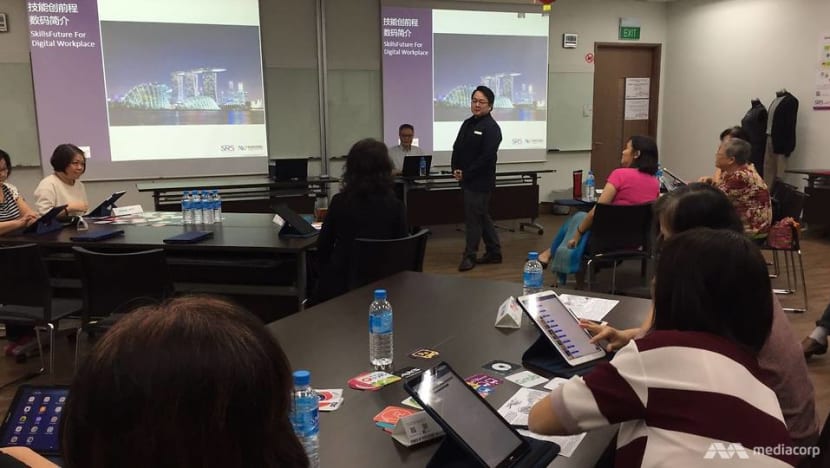commentary Commentary
Commentary: It took a while but Singaporean workers are finally embracing lifelong learning
Lifelong learning in Singapore has often been characterised as a work-in-progress, needing more pushing and prodding for over two decades, says NIE’s Jason Tan.

As mature workers, mid-career jobseekers are understandably anxious about the drastic confluence of digital disruptions, outmoded skills and ageism working against them.
SINGAPORE: In education, we believe challenges bring “teachable moments”.
We tend to think that despite how much stress and uneasiness adversity creates, these offer fresh opportunities for personal growth and professional development.
Perhaps many of us educators are optimists.
But in a year where so much has been disrupted by COVID-19, a sense of hope can give us greater gumption to stare down the chasm created by the coronavirus to focus on the positives of needed change.
DIFFERENCES IN FATES EVEN IN THE SAME SECTOR
Many industries have been upended over the past 10 months. Billions of lives have had to cope with disruption.
The pandemic has accelerated mega-trends such as digitalisation and artificial intelligence, which have increased the pace of job displacement.
READ: Commentary: Every day feels like 11.11 since COVID-19
Though Singapore has weathered the first phase of the storm well, we cannot underestimate the far-reaching implications.
While the Jobs Support Scheme managed to put many jobs into suspended animation until firms could get a firm footing, the economy continued to shrink at 5.6 per cent in the third quarter.
Interestingly, while many firms, beloved restaurants and more, have had to shutter, interesting many sectors are offering record number of positions as organisations pivot towards new business opportunities.
Food services supplying hotels, restaurants and cafes saw a 40 to 90 per cent dip in sales as of September, compared to a 30 to 70 per cent surge in food manufacturing.

Such developments underscore the need for re-training and upskilling: By reminding us that we can thrive amid a generational maelstrom, and even in the same industry, if we embrace lifelong learning.
CREATING A LEARNING SOCIETY
A global push towards lifelong learning has been underway for decades. A seminal report addressing lifelong learning was published by the United Nations Educational, Scientific and Cultural Organisation (UNESCO) in 1996.
The report advanced the idea of a “learning society” founded on the “acquisition, renewal and use of knowledge” in response to major contextual factors such as worldwide interdependence and globalisation, growing inequalities in development, and the challenges posed by the new information technologies.
READ: Commentary: The cult of work is eroding the value of parenthood
The UNESCO Education Commission recommended four pillars of education, among which was “learning to know”, in the laying of a solid foundation for lifelong learning through the combining of a sufficiently broad general education with the possibility of in-depth study of a selected number of subjects, as well as learning to learn.
Singapore’s push towards lifelong learning arguably started almost the same time UNESCO released its report.
Then Prime Minister Goh Chok Tong had launched in 1997, the Thinking Schools, Learning Nation vision, to encourage young Singaporeans to develop a lifelong passion for learning in the nation’s drive towards a knowledge economy.
Yet lifelong learning has often been characterised as a work-in-progress, needing more pushing and prodding in the two decades since.
READ: Commentary: PSLE scores and the problem with the beloved late bloomer narrative
READ: Commentary: Kids taking PSLE next year may have a very different experience
But in recent years, the education system has evolved to keep pace with the realisation that a digital economy prone to disruption urgently needs to prepare its future workforce. Singapore’s schooling system strengthened the four pillars of education.
The Ministry of Education has focused on reducing the emphasis on assessment demands in schools and promote the intrinsic joy of learning.

Beginning from 2019, students in Primary 1 and 2 no longer have weighted assessments or examinations while Secondary 1 pupils don’t need to sit for mid-year exams. From this year and next, students in Primary 3, Primary 5 and Secondary 3 will also be exempted from mid-year exams.
By 2024, streaming will be phased out and full subject-based banding be implemented across secondary schools.
More emphasis has also been placed on education and career guidance in schools and institutes of higher learning, while work-study programmes have been instituted in polytechnics and the Institute of Technical Education (ITE).
From 2018, ITE students can choose to enrol in the work-study diploma programme where about 70 per cent of curriculum time is spent at work and the rest in class.
LEVERAGING ON SKILLSFUTURE
Recognising that lifelong learning must involve the creation of strong institutions beyond the education sector, the Government launched the SkillsFuture initiative in 2015 to catalyse a love for learning in working adults.
READ: Commentary: Worried about keeping your job? Here’s advice to soothe your concerns no matter how old you are
This initiative has been strengthened to create stronger linkages between training and work, through Adapt and Grow, a mid-career transition programme which placed 30,000 people in new roles in 2018, and Earn and Learn, a work-study programme for diploma holders and ITE graduates.
As he announced the expansion of SkillsFuture work-study programmes in August, Education Minister Lawrence Wong explained: “We strive to foster the joy of learning in our students, so that Singaporeans are equipped not just with knowledge and skills, but also with the spark to pursue their passion and fulfil their potential.”

In other words, SkillsFuture is not to be narrowly confined to employability concerns, but rather to be part of a route towards self-realisation and personal development, blurring the lines between the life phases of education and work.
Despite this ambitious attempt at entrenching a lifelong learning society in Singapore, there are issues to it becoming a reality.
GETTING PEOPLE TO THE CLASSROOMS
For one, while the SkillsFuture is a laudable plan, will everyone subscribe to it?
An area of concern has long been low levels of skills confidence among seniors who had not completed secondary schooling, particularly when regarding digital or technological skills, which could become an impediment in the mode of learning and possible career choices.
READ: Commentary: To survive COVID-19 disruptions, Singaporeans must learn how to learn better
For instance, researchers at the Institute for Adult Learning (IAL) have found a relatively sharp decline in engagement with technologies for learning among those between the ages of 40 and 70 years.
Then-Nominated Member of Parliament Anthea Ong highlighted the struggles faced by low-income households, the differently-abled and seniors in terms of digital literacy and skills.
“Some do not have the skills-set to take their work online especially when their previous work was done face-to-face. This can mean loss of income and opportunities to retrain or learn new skills,” she wrote in a CNA commentary in May.
In addition, the IAL researchers also found that participation in lifelong learning is significantly influenced by how much recognition certification is given.

In a closed-door discussion on SkillsFuture and employability organised by the Institute of Policy Studies in February 2018, one of the guest speakers Nur Ellisa Abdul Rahman, then a Sales Support Manager, said “that the lack of recognition for Workforce Skills Qualification (WSQ) by businesses, especially small and medium enterprises, would prevent working adults from taking up SkillsFuture courses.”
The problem, she added, was that there was a lack of clarity of how a WSQ diploma measured up to diplomas provided for by private institutes, polytechnics and the ITE.
These factors are likely to have contributed to the low take-up rate for SkillsFuture. Official reports show training participation rates are still at less than half (49 per cent) of the eligible population in 2019 despite it rising from 35 per cent in 2015.
WILL IT MEET ITS AIMS?
There is also the danger that the SkillsFuture programme, while well-intended, may result in distorted outcomes.
For example, while the SkillsFuture manifesto explicitly promotes skills mastery over mere paper qualifications, there is always the danger pre-existing societal preoccupation with the latter will turn SkillsFuture into yet another paper chase.
READ: Commentary: No worker is untrainable. Employers have to step up to help
READ: Commentary: How COVID-19 has forced employers to be more human – and rewards them in the process
Meanwhile, policymakers have to ensure that the quest for greater employability amid volatile economic circumstances does not jeopardise other valued aspects of lifelong learning, such as inclusivity and personal fulfilment.
For someone from a lower socio-economic status, finding a job to put food on the table and pay bills is likely to triumph considerations of personal gain from learning.

So even if participation rates in programmes are high, it doesn’t mean that people are necessarily doing it because they enjoy learning. Rather they could be compelled by short-term pandemic-related economic reasons.
PERCEPTIONS AND EMOTIONS MATTER
Might old mind-sets about the kind of work we each aspire towards hold us back from pivoting to new roles and industries and truly embracing lifelong learning if the subjects are far from our idea role?
This traditional devaluing of what author David Goodhart, in his recently published book Head, Hand, Heart, calls “hand” (manual and craft) work and “heart” (caring, emotional) work in favour of “head” (cognitive) work may exert a powerful influence over workers’ willingness to explore alternative spheres of work.
READ: Commentary: More bold measures needed to protect against the job losses heading Singapore's way
Goodhart claims that cognitive-analytical ability, or the talent to pass examinations and then handle information efficiently in professional work, has become “the gold standard of human esteem.”
A “head” professional would not likely consider switching to blue-collar or “hand” work. This may impact the take-up of SkillsFuture courses, largely seen as a programme aimed at training people for “hand” work.
Recognise that human learning is also a social and emotional one can help uncover encumbrances to learning.

After all, one’s learning attitudes are deeply shaped by one’s social environment and personal circumstances.
Individual concerns over a potential “loss of face” and the ease of adjustment to a totally new sphere of work cannot be summarily dismissed as evidence of an overly finicky job-seeker, especially in the case of mid-career individuals.
A service-level worker in his or her 50s who has had no technological background may be concerned if he or she is able to cope with a new career in IT services against younger and more tech-savvy colleagues despite undergoing a relevant course.
READ: Commentary: Soon you may be competing with talent globally. The Fortitude Budget is a wake-up call
READ: Commentary: Home-based learning is strange, new ground. But we can conquer that too
It has proven much easier to change “hardware” by instituting new programmes and courses than to change people’s attitudes towards learning, the social environment that shapes those attitudes, as well as to improve access for marginalised segments of the population.
There is hope that current education reforms in the direction of developing all four pillars of learning among school students will bear fruit in due course and help shift some of these attitudinal factors.
Encouragingly, signs show that COVID-19 has warmed people up more towards the idea of training and lifelong learning.
According to SkillsFuture Singapore, 12,950 training opportunities under the SGUnited Skills programme – part of the SGUnited Jobs and Skills Package to help job seekers during the pandemic - opened up in July and August. Over 13,000 people signed up for them in the same period.
Employers too are finding value in training.
As at June, nearly 800 companies had taken up training spots under the Enhanced Training Support Package (ETSP), which gives all employers absentee payroll support at 90 per cent of workers' hourly basic salary.
Perhaps COVID-19 might provide that needed nudge.
Jason Tan is an associate professor at the National Institute of Education.














